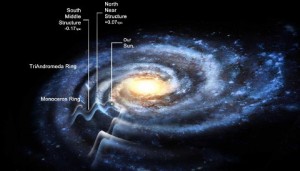Ripples found in the Milky Way’s disk reveal our galaxy survived an ancient hit-and-run. Now, astronomers might have caught the culprit.

Dana Berry
A few hundred million years ago, a small galaxy had a fender-bender with the Milky Way. Even as it fled the crime scene, it sent ripples coursing through the Milky Way’s disk. Invisible and thousands of light-years beyond our galaxy’s outer edge, it remained undiscovered for years.
Now with the help of a trio of brightly pulsating stars, Sukanya Chakrabarti (Rochester Institute of Technology) and her colleagues say they have caught the fugitive dwarf galaxy.
If correct, the study could mark the first application of galactoseismology. Just as seismologists analyze earthquakes to infer properties about the Earth’s invisible interior, galactoseismologists would analyze waves in the galactic disk to map the Milky Way and to search for any dark neighbors.
Stirring up Trouble
Chakrabarti compares the quest to finding “Planet X.” For decades, astronomers have noticed peculiarities in the orbits of nearby planets and wondered if some massive planet lurking in the far outer reaches of our solar system might be stirring up trouble. When astronomers sought a Planet X beyond Uranus, they found Neptune. When they sought one beyond Neptune, they found Pluto. More, recently they’ve even sought one beyond the Kuiper Belt.
In like fashion, when Chakrabarti modeled the ridges and grooves in our galaxy’s disk back in 2009, she found they pointed toward a past collision with an object only one-hundredth the Milky Way’s mass. Her analysis with Leo Blitz (University of California, Berkeley) suggested the object now lies about 300,000 light-years, or 90 kiloparsecs, from the Milky Way’s center.
But spotting a dwarf galaxy beyond the plane of the Milky Way, which blocks most of the more-distant light, was no easy task. “You can imagine [that] if we have a hard time finding a planet in our own solar system … [then] to find something at a distance of 90 kpc, which is much further away, is going to be hard.”
Fast-Flying Stars Mark the Spot
It took six years before Chakrabarti and her colleagues found what they were looking for: four stars located toward the Norma constellation — the exact spot where she had predicted the runaway galaxy hid. But in order to definitely prove these stars belonged to the hit-and-run fugitive, the astronomers had to confirm that the stars were located well outside the Milky Way and rapidly on the move.
The team thought the stars could be classical Cepheid variables — a class of so-called standard candles that regularly expand and collapse at a rate directly related to their brightness. Such a simple relation allows astronomers to easily determine their distances. But only one of the four panned out. In 2015, Pawel Pietrukowicz (Warsaw University Observatory, Poland) and his collaborators took a closer look at three out of the four stars. By comparing the stars to nearly half a million variable stars in the OGLE project, they confirmed that one of the stars was in fact a variable star, although likely not a Cepheid, while the other two appeared static.
So Chakrabarti kept the only confirmed variable star and pushed on until she discovered two more. Still, Pietrukowicz disagrees that the three stars in this new sample are true Cepheids. Although he and his colleagues haven’t observed the additional two, he worries that there’s far too little information about the stars’ changing brightnesses for a true confirmation. They could easily be binary stars or stars with dark spots that spin in and out of view — both would mimic the pulsation expected from a Cepheid, he says.
Chakrabarti acknowledges the problem. The confirmed variable star’s brightness doesn’t rise and fall like most classical Cepheids in our galaxy, she says. Instead, the star better resembles Cepheids in the Small Magellanic Cloud. The result isn’t too surprising since you’d expect the fugitive’s Cepheids to resemble those in other dwarf galaxies rather than those found in our massive spiral galaxy, she says.
Whether or not the stars prove to be Cepheids, Chakrabarti does think they are a good starting point. Follow-up observations of the shift in the stars’ spectral lines reveal velocities that clock in at roughly 156 km/s (349,000 mph) — an order of magnitude larger than the stars in the disk of our galaxy. They clearly don’t belong to the Milky Way.
With multiple lines of evidence (even if the first one is admittedly hazy), Chakrabarti and her team are pretty convinced that the story holds up. “The only way you can have multiple stars like this, outside of our galaxy and very close together is if they were part of their own galaxy,” says coauthor Joshua Simon (Carnegie Observatories).
Reference:
Sukanya Chakrabarti et al. “Galactoseismology: Discovery of a cluster of receding, variable halo stars.” Submitted to Astrophysical Journal Letters.
 1
1









Comments
DAVID
February 5, 2016 at 10:27 pm
Why would gravity not cause the galaxies to be absorbed? I don't understand how gravity of the two galaxies would allow a hit and run scenerio. Wouldn't the centers be attracted to each other?
You must be logged in to post a comment.
You must be logged in to post a comment.